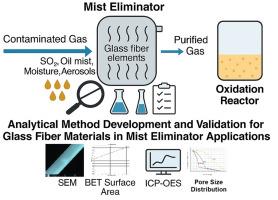New insights into the structural integrity of glass fibre mist eliminators
IF 3.4
4区 化学
Q2 CHEMISTRY, MULTIDISCIPLINARY
引用次数: 0
Abstract
Mist eliminators are critical components in gas purification systems, effectively removing entrained aerosols and fine particulates. The performance of these eliminators is highly dependent on the physical properties of the coalescing media, particularly the type and quality of glass fibres used. This study brings advancement in scientific insights of industrial glass fiber system by establishing a clear structure performance relationship for glass fiber materials used in mist eliminators. A combination of advanced characterization techniques (ICP-OES, SEM, BET surface area, permeability test, XRD, acid resistance test) was employed to assess structural, textural, and functional properties of various conventional and alternative glass fibre materials. The pore size distribution and permeability testing studies demonstrated that larger fiber diameters and wider pore distributions compromise packing density and mist capture efficiency, whereas controlled pore size and uniform distribution enhances droplet–fiber interaction, coalescence, and pressure stability. The results reveal that among the alternate fibres studied, GF-A exhibited properties most comparable to the reference conventional glass fibre, including high acid resistance, uniform fibre diameter, appropriate surface area, and optimal gas flow characteristics. While GF-C, though chemically stable, was eliminated due to oversized pores and poor coalescence performance. Accordingly, this work provides a validated framework for selecting coalescing materials in industrial gas purification systems, ensuring long-term catalyst protection and operational reliability.

对玻璃纤维消雾器结构完整性的新见解
除雾器是气体净化系统的关键部件,可有效去除夹带的气溶胶和细颗粒物。这些消除剂的性能高度依赖于凝聚介质的物理特性,特别是所使用的玻璃纤维的类型和质量。本研究建立了用于除雾器的玻璃纤维材料清晰的结构性能关系,为工业玻璃纤维体系的科学认识带来了进步。结合先进的表征技术(ICP-OES, SEM, BET表面积,渗透性测试,XRD,耐酸测试)来评估各种传统和替代玻璃纤维材料的结构,纹理和功能特性。孔径分布和渗透率测试研究表明,较大的纤维直径和较宽的孔隙分布会影响堆积密度和雾捕获效率,而控制孔径和均匀分布则会增强液滴与纤维的相互作用、聚结和压力稳定性。结果表明,在所研究的替代纤维中,GF-A具有与参考传统玻璃纤维最相似的性能,包括高耐酸性,均匀的纤维直径,合适的表面积和最佳的气体流动特性。而GF-C虽然化学性质稳定,但由于孔隙过大、聚结性能差而被淘汰。因此,这项工作为工业气体净化系统中聚结材料的选择提供了一个经过验证的框架,确保了催化剂的长期保护和运行可靠性。
本文章由计算机程序翻译,如有差异,请以英文原文为准。
求助全文
约1分钟内获得全文
求助全文
来源期刊
CiteScore
3.50
自引率
7.70%
发文量
492
审稿时长
3-8 weeks
期刊介绍:
The Journal of the Indian Chemical Society publishes original, fundamental, theorical, experimental research work of highest quality in all areas of chemistry, biochemistry, medicinal chemistry, electrochemistry, agrochemistry, chemical engineering and technology, food chemistry, environmental chemistry, etc.

 求助内容:
求助内容: 应助结果提醒方式:
应助结果提醒方式:


